Sue Pertwee-Tyr
Accuphase all the way down
By my reckoning, that’d be a stand about 12m tall, which probably puts the tweeters above ear height1/2 a dozen broom shafts and two pieces of plywood? @Tony L
By my reckoning, that’d be a stand about 12m tall, which probably puts the tweeters above ear height1/2 a dozen broom shafts and two pieces of plywood? @Tony L
By my reckoning, that’d be a stand about 12m tall, which probably puts the tweeters above ear height.
I didn't say he made glulams, I am saying the term cld is often applied (erroneously) to several layers of different (or the same) materials, glued together. These are glulams, not cld. As you point out, cld is (in its simplest form) made of a layer of material to be damped, then a viscoelastic layer, and finally the constraining layer. BUT, cld only works if all the layers bend a little, to stretch the VE layer, and thereby incur losses by shearing. And that 'very thin' layer is also important, (as is the thin panels). If you look at his demo of how things bend (a very good illustration, IMHO) you will see how much effort is needed. I'm sure those forces are not produced in a loudspeaker cabinet. For cld to work properly, all layers have to be thin, very thin. Of course, all this is academic if single layer products are used which have greater damping ability. The ones illustrated/demo'ed do not seem to have much damping, cld or not.
CLD is more effective than the BBC 'thin wall / thick damping' for an equivalent thickness material.
So If you think CLD is ineffective, you must believe the BBC were completely wasting their time with the thin wall / thick damping speaker cabinets.
The BBC research is 50 years old... And if I'm not mistaken weight and portability rated high in the design brief.
CLD is more effective than the BBC 'thin wall / thick damping' for an equivalent thickness material (stiffer and with better damping).
So If you think CLD is ineffective, you must believe the BBC were completely wasting their time with the thin wall / thick damping speaker cabinets.
CLD is more effective than the BBC 'thin wall / thick damping' for an equivalent thickness material (stiffer and with better damping).
So If you think CLD is ineffective, you must believe the BBC were completely wasting their time with the thin wall / thick damping speaker cabinets.
Also, in the video when the guy let go of that 'tiny little' weight that was attached to a wire, and took a measurement, the difference was easily measured and significant. Do you really believe that little weight was heavy enough, and had enough force to bend the material? Because you are saying the material has to be bent significantly before CLD will have an effect, and that is clearly wrong.
They look really good and nicely made. Did you compare them to anything metal?
The thing that is often overlooked with the BBC designs IMO is the thin-wall was only part of it. Screwed rather than glued baffles are I suspect at least as significant in breaking resonance, as is the very conscious decision to keep resonance low in frequency and low in Q. There was a lot of joined-up thinking there that is IMHO miles ahead of the dumb glued heavy MDF boxes the modern hi-fi world is now littered with at all price-points. It is the difference between real scientific research and some random audiophile brand with a table saw, a few off the shelf drivers, and little if any clue about physics. As stated upthread it is interesting to contrast just how much further along pro-audio brands (Neumann, Genelec etc) have taken cabinet design in past decades. That the classic BBC designs still command so much respect 50 years later shows just how stagnant home audio speaker design has become.
PS The thing I liked about the video upthread was about five of the six or so alleged benefits for MDF the guy gave were that it was very cheap. That’s it in a nutshell. I would love to hear those Voight speakers.
I didn't state cld was ineffective, I said that from the results shown in the video, it seems a huge amount of work has been done with very little reward. My conclusion is that cld was NOT at work here, and the FACT that some single materials have MUCH better damping. The BBC boxes were not cld either! but they worked out OK. And yes, the viscoelastic layer has to bend, to use shearing to dissipate the energy. The substrate (that layer to be damped) and the constraining layer will also have to bend, microscopically, but they do bend. Thick panels do not. If you refuse to believe me, just read a few hundred scientific papers on the subject, as I have. I don't see cld helping much with loudspeaker damping, unless it's on the aluminium cylinders in the JR149 design (thin aluminium, which has a damping factor (without cld) of 0.004 (equivalent to a Q factor of 250!!), or just less that the SQRT of sod all).
I agree with Tony (a lot) on this subject, especially about mdf, which has very low amounts of intrinsic damping.
I learnt about sound transmission at college, and sound will still travel through screws. The only way to reduce it significantly is to decouple the baffle.
Yes, and it's still used now by some manufacturers.
For all I know, the BBC may have considered CLD but didn't bother due to cost and/or weight reasons. I'm sure the BBC had their reasons to do what they did, and I'm not disputing that, I'm just trying to show Hellnback that CLD is effective.
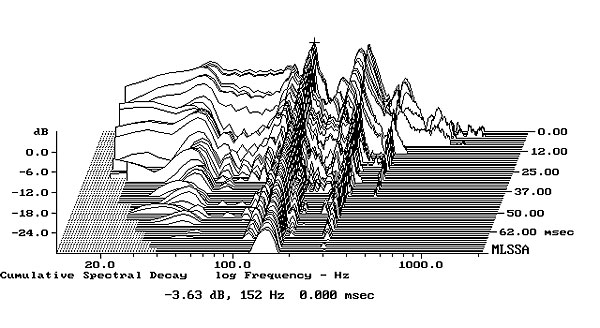
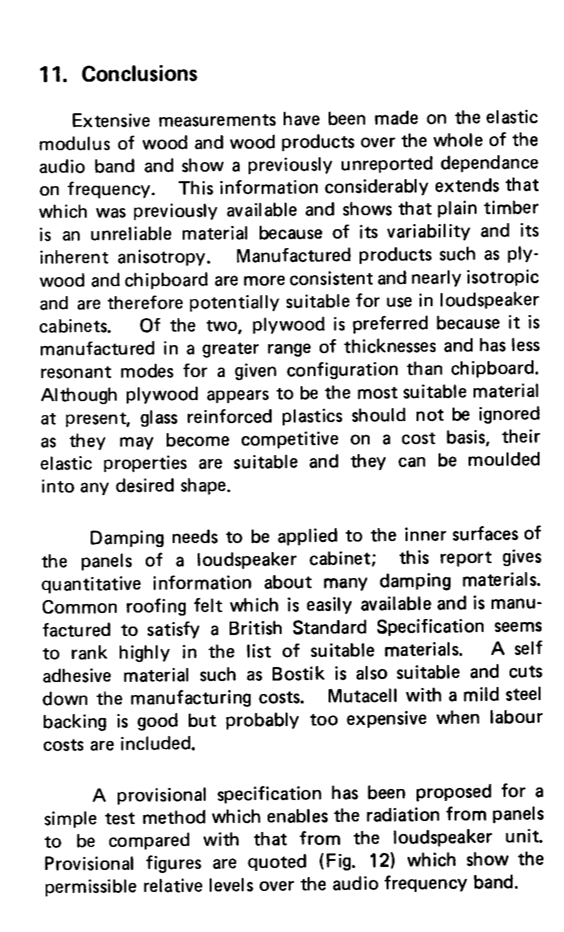
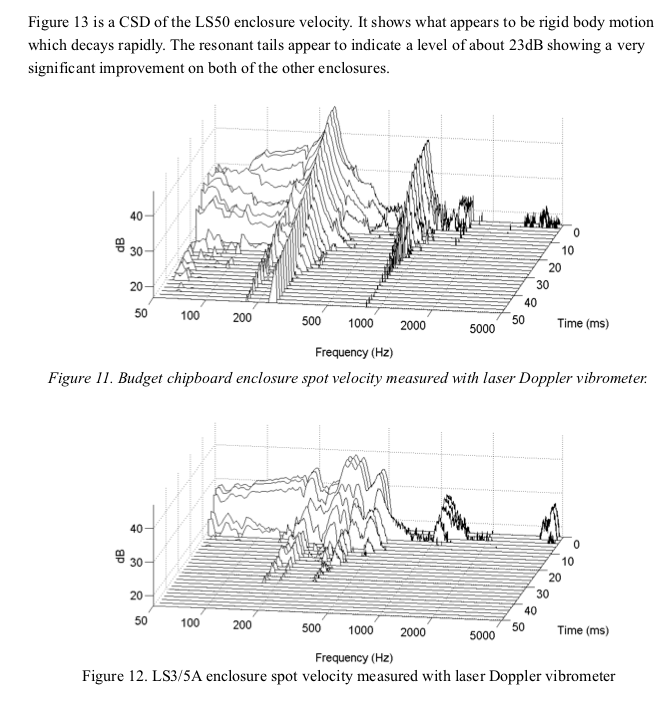
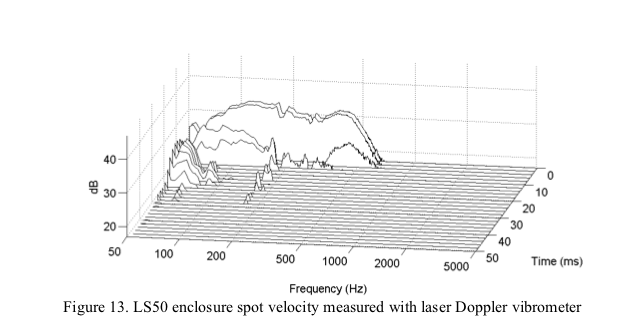
But if you look at Stereophile's cabinet resonance measurements Falcon's, Harbeth's, Spendor's and Stirling's designs still produce very significant resonances, for example:
As stated above I personally don’t view Harbeth as anything other than BBC influenced/marketed. Their cabinets are MDF, a material that didn’t even exist back when the BBC did all the research. It is also a material with entirely different properties to the damped ply of say a LS3/6. You can play an SHL5 like a conga drum, it is a remarkably resonant box!
PS I have a lot of respect for the Kef LS50. One of the most interesting home audio speaker designs of the past 40 years IMHO. In no way would I describe it as the typically lazy glued MDF box, a huge amount of real research went into all aspects of driver and cabinet design. My only criticism is it is manufactured in a dictatorship with an appalling human rights record, but so is the iPad I’m typing this response on.
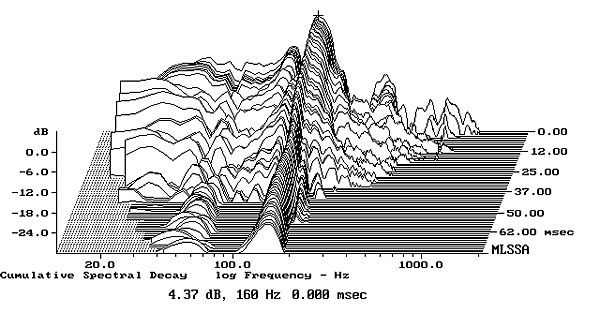
Areas with constrained layer damping can be seen in this photo:
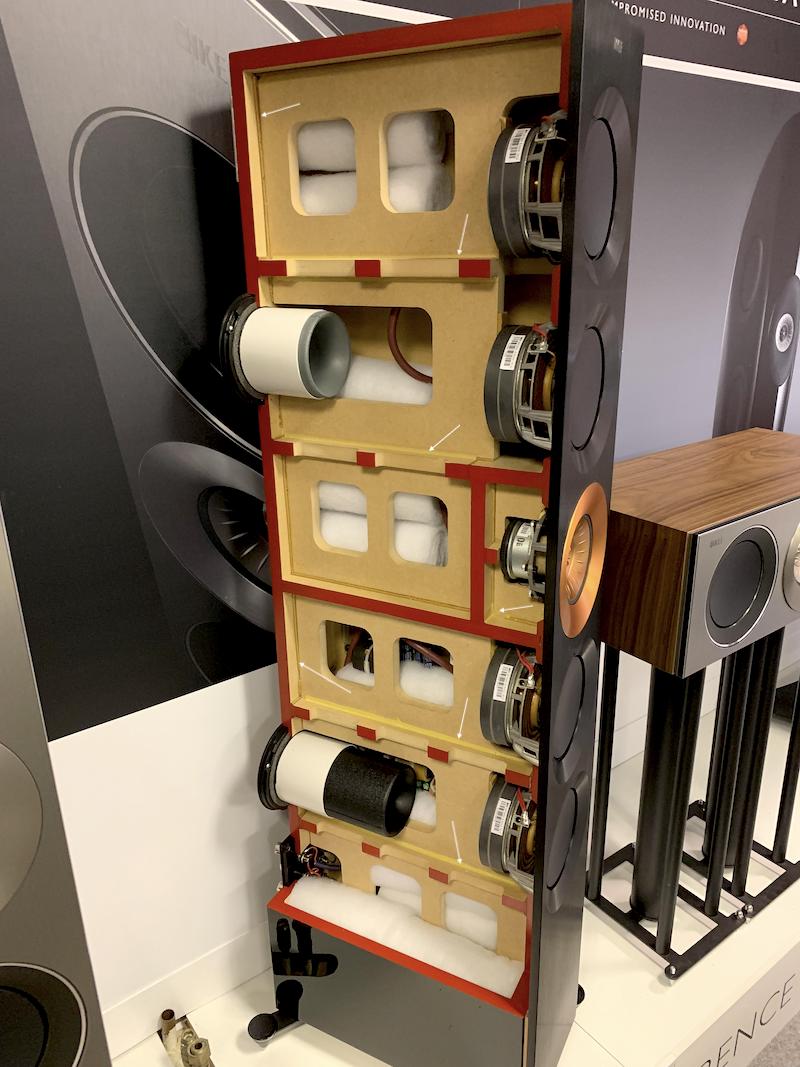
Are you sure they have CLD? It looks like the braces may have a gap filled with damping compound where they fix to the inside of the enclosure, but I don't see CLD. Tannoy did something very similar with their DMT studio monitors.
